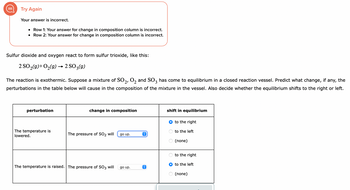Sulfur dioxide and oxygen react to form sulfur trioxide, like this: 2 SO₂(g) + O₂(g) → 2 SO 3(g) The reaction is exothermic. Suppose a mixture of SO2, O₂ and SO3 has come to equilibrium in a closed reaction vessel. Predict what change, if any, the perturbations in the table below will cause in the composition of the mixture in the vessel. Also decide whether the equilibrium shifts to the right or left. perturbation The temperature is lowered. change in composition The pressure of SO₂ will ✓ ? The temperature is raised. The pressure of SO3 will go up. go down. not change. ? shift in equilibrium Oto the right to the left ○ (none) to the right Oto the left O (none) x
Sulfur dioxide and oxygen react to form sulfur trioxide, like this: 2 SO₂(g) + O₂(g) → 2 SO 3(g) The reaction is exothermic. Suppose a mixture of SO2, O₂ and SO3 has come to equilibrium in a closed reaction vessel. Predict what change, if any, the perturbations in the table below will cause in the composition of the mixture in the vessel. Also decide whether the equilibrium shifts to the right or left. perturbation The temperature is lowered. change in composition The pressure of SO₂ will ✓ ? The temperature is raised. The pressure of SO3 will go up. go down. not change. ? shift in equilibrium Oto the right to the left ○ (none) to the right Oto the left O (none) x
Chemistry
10th Edition
ISBN:9781305957404
Author:Steven S. Zumdahl, Susan A. Zumdahl, Donald J. DeCoste
Publisher:Steven S. Zumdahl, Susan A. Zumdahl, Donald J. DeCoste
Chapter1: Chemical Foundations
Section: Chapter Questions
Problem 1RQ: Define and explain the differences between the following terms. a. law and theory b. theory and...
Related questions
Question

Transcribed Image Text:Sulfur dioxide and oxygen react to form sulfur trioxide, like this:
2 SO₂(g) + O₂(g) → 2 SO 3(g)
The reaction is exothermic. Suppose a mixture of SO2, O₂ and SO3 has come to equilibrium in a closed reaction vessel. Predict what change, if any, the
perturbations in the table below will cause in the composition of the mixture in the vessel. Also decide whether the equilibrium shifts to the right or left.
perturbation
The temperature is
lowered.
change in composition
The pressure of SO₂ will ✓?
The temperature is raised. The pressure of SO3 will
go up.
go down.
not change.
?
↑
shift in equilibrium
OO
OOO
X
to the right
to the left
(none)
to the right
to the left
(none)
Ś
Expert Solution
This question has been solved!
Explore an expertly crafted, step-by-step solution for a thorough understanding of key concepts.
This is a popular solution!
Trending now
This is a popular solution!
Step by step
Solved in 3 steps

Follow-up Questions
Read through expert solutions to related follow-up questions below.
Follow-up Question

Transcribed Image Text:Try Again
Your answer is incorrect.
• Row 1: Your answer for change in composition column is incorrect.
• Row 2: Your answer for change in composition column is incorrect.
Sulfur dioxide and oxygen react to form sulfur trioxide, like this:
2 SO₂(g) + O₂(g) → 2 SO 3(g)
The reaction is exothermic. Suppose a mixture of SO₂, O₂ and SO3 has come to equilibrium in a closed reaction vessel. Predict what change, if any, the
perturbations in the table below will cause in the composition of the mixture in the vessel. Also decide whether the equilibrium shifts to the right or left.
perturbation
The temperature is
lowered.
change in composition
The pressure of SO₂ will
The temperature is raised. The pressure of SO3 will
go up.
go up.
↑
shift in equilibrium
to the right
to the left
(none)
to the right
to the left
(none)
Solution
Knowledge Booster
Learn more about
Need a deep-dive on the concept behind this application? Look no further. Learn more about this topic, chemistry and related others by exploring similar questions and additional content below.Recommended textbooks for you

Chemistry
Chemistry
ISBN:
9781305957404
Author:
Steven S. Zumdahl, Susan A. Zumdahl, Donald J. DeCoste
Publisher:
Cengage Learning

Chemistry
Chemistry
ISBN:
9781259911156
Author:
Raymond Chang Dr., Jason Overby Professor
Publisher:
McGraw-Hill Education

Principles of Instrumental Analysis
Chemistry
ISBN:
9781305577213
Author:
Douglas A. Skoog, F. James Holler, Stanley R. Crouch
Publisher:
Cengage Learning

Chemistry
Chemistry
ISBN:
9781305957404
Author:
Steven S. Zumdahl, Susan A. Zumdahl, Donald J. DeCoste
Publisher:
Cengage Learning

Chemistry
Chemistry
ISBN:
9781259911156
Author:
Raymond Chang Dr., Jason Overby Professor
Publisher:
McGraw-Hill Education

Principles of Instrumental Analysis
Chemistry
ISBN:
9781305577213
Author:
Douglas A. Skoog, F. James Holler, Stanley R. Crouch
Publisher:
Cengage Learning

Organic Chemistry
Chemistry
ISBN:
9780078021558
Author:
Janice Gorzynski Smith Dr.
Publisher:
McGraw-Hill Education

Chemistry: Principles and Reactions
Chemistry
ISBN:
9781305079373
Author:
William L. Masterton, Cecile N. Hurley
Publisher:
Cengage Learning

Elementary Principles of Chemical Processes, Bind…
Chemistry
ISBN:
9781118431221
Author:
Richard M. Felder, Ronald W. Rousseau, Lisa G. Bullard
Publisher:
WILEY